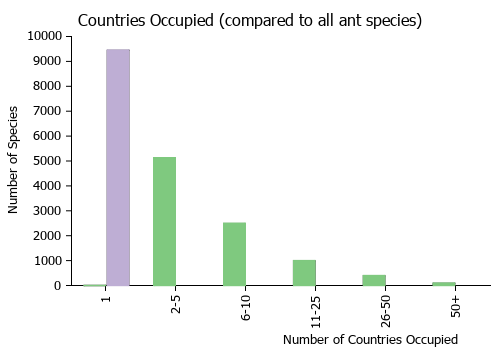Strumigenys bibis
| Strumigenys bibis | |
|---|---|
| Scientific classification | |
| Kingdom: | Animalia |
| Phylum: | Arthropoda |
| Class: | Insecta |
| Order: | Hymenoptera |
| Family: | Formicidae |
| Subfamily: | Myrmicinae |
| Tribe: | Attini |
| Genus: | Strumigenys |
| Species: | S. bibis |
| Binomial name | |
| Strumigenys bibis Bolton, 2000 | |
The holotype worker was found under a log in a Eucalyptus woodland.
Identification
Bolton (2000) - A member of the Strumigenys emmae-group. The relatively long mandibles and scapes of bibis quickly set it apart from other members of the group; this is the only species whose exposed mandibles at full closure are longer than the maximum clypeal width. The mandibles, with MI 42, exceed the range of the other species, which have a combined MI of 26-36. The scape of bibis is not dorsoventrally flattened and is longer and more slender than any species except Strumigenys sutrix (SI 70-73); its SI is 72 and its SL about 6.0 X the maximum scape width. In the other species the scape is shorter, broader and strongly dorsoventrally flattened; combined SI range is 56-67 and SL is only about 3.0 X the maximum scape width, or less.
Identification Keys including this Taxon
Distribution
Latitudinal Distribution Pattern
Latitudinal Range: -13.18333333° to -13.18333333°.
| North Temperate |
North Subtropical |
Tropical | South Subtropical |
South Temperate |
- Source: AntMaps
Distribution based on Regional Taxon Lists
Australasian Region: Australia (type locality).
Distribution based on AntMaps
Distribution based on AntWeb specimens
Check data from AntWeb
Countries Occupied
| Number of countries occupied by this species based on AntWiki Regional Taxon Lists. In general, fewer countries occupied indicates a narrower range, while more countries indicates a more widespread species. |

|
Estimated Abundance
| Relative abundance based on number of AntMaps records per species (this species within the purple bar). Fewer records (to the left) indicates a less abundant/encountered species while more records (to the right) indicates more abundant/encountered species. |

|
Biology
Castes
|
Nomenclature
The following information is derived from Barry Bolton's Online Catalogue of the Ants of the World.
- bibis. Strumigenys bibis Bolton, 2000: 950, fig. 519 (w.) AUSTRALIA.
Type Material
- Holotype, worker, 9km NW Adelaide River, Northern Territory, Australia, Ward,P.S., ANIC32-017754, Australian National Insect Collection.
Unless otherwise noted the text for the remainder of this section is reported from the publication that includes the original description.
Description
Worker
HOLOTYPE, TL 2.0, HL 0.55, HW 0.39, CI 71, ML 0.23, MI 42, SL 0.28, SI 72, PW 0.27, AL 0.54. Exposed length of fully closed mandible greater than width of anterior clypeal margin. Antenna with 4 segments; second funicular segment much longer than broad. Leading edge of scape quite evenly shallowly convex, the median third of its length not dorsoventrally flattened nor expanded into an obtusely angular prominence or lobe. Hairs that fringe the leading edge of the scape small, spatulate to narrowly spoon-shaped. Cephalic dorsum with narrowly spoon-shaped ground-pilosity that is strongly curved; without orbicular hairs. Pronotal humeral hair flattened, strongly expanded apically. Ground-pilosity of promesonotum spatulate to narrowly spoon-shaped; here and there with a few larger hairs that are more erect and more strongly flattened and expanded at the apex. Promesonotal dorsum with sculpture fai nt and largely effaced, finely superficially shagreenate. Disc of postpetiole entirely smooth; sides of disc in dorsal view not surrounded by projecting spongiform tissue. Standing hairs on first gastral tergite dense, short and stubbly, clavate apically. Basigastral costulae short, their length on tergite proper no greater than width of limbus, much less than length of postpetiole disc.
References
- Bolton, B. 2000. The ant tribe Dacetini. Memoirs of the American Entomological Institute. 65:1-1028. (page 950, fig. 519 worker described)


